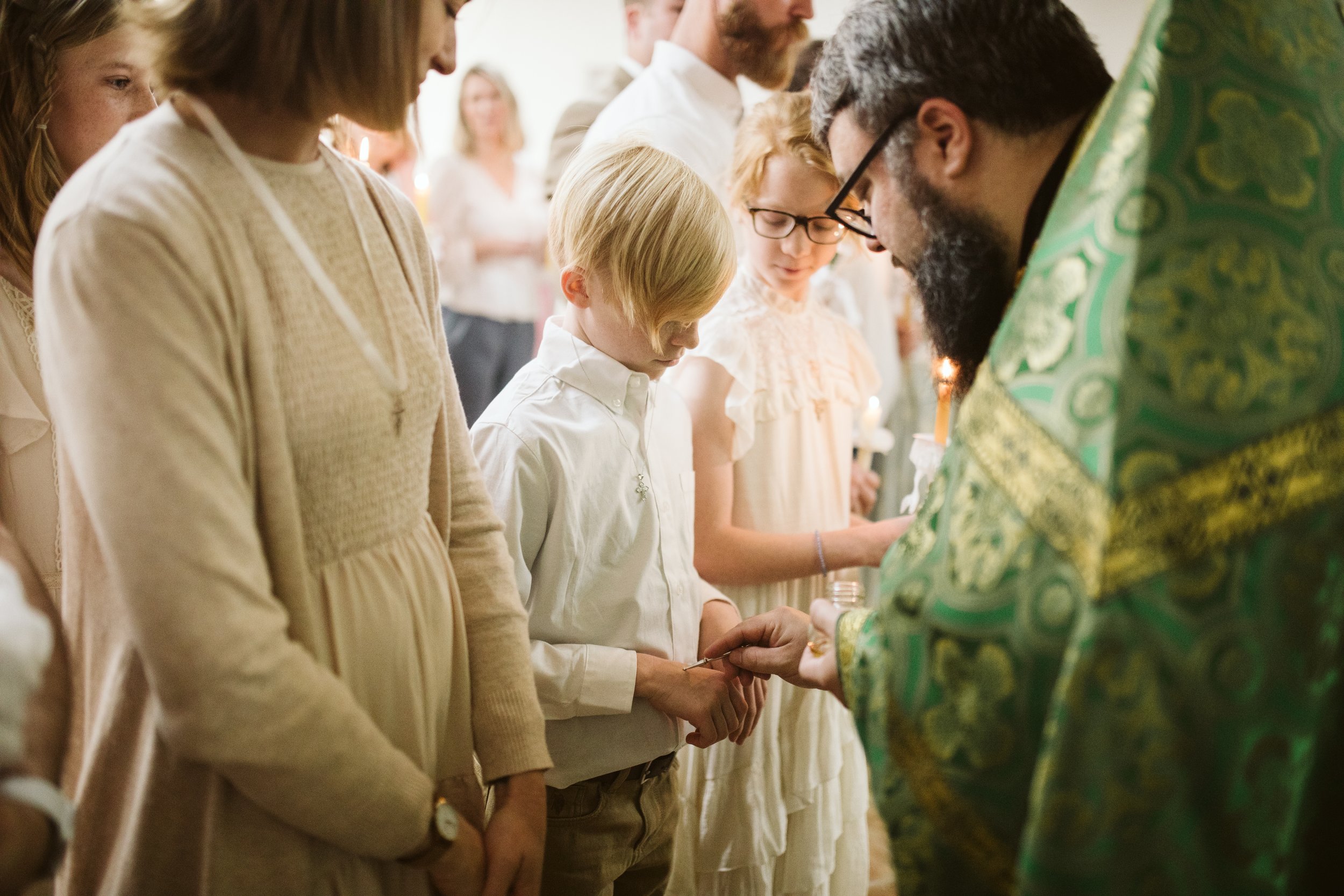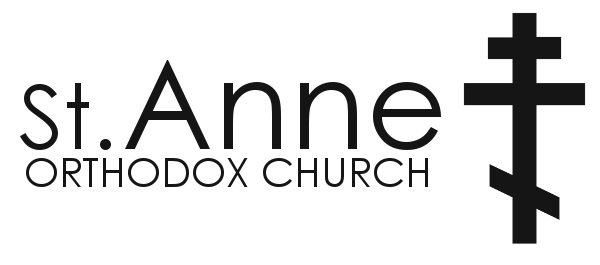
FIRST TIME VISITORS
A wonderful explanation from St. Barnabas Orthodox Church!
Specifics altered to match our parish details.
+ What is the parish community like?
Our parish is more than just a place where people come to worship the living God (although it is also that!). Saint Anne is a vibrant faith community of people of all ages and backgrounds throughout Knoxville, Oak Ridge, and surrounding communities, who are living their faith together and raising their families in accordance with the commandments of Our Lord and Savior Jesus Christ and the canons of the ancient Holy Eastern Orthodox Church.
Many of our congregants journeyed to the Orthodox Church from other Christian faith traditions and denominations and some non-Christian religious and spiritual traditions. So whether you are “on a journey” or just wanting to visit a local Orthodox parish, you will be welcome at Saint Anne.
+ Are non-Orthodox visitors welcome?
Yes! You are welcome here. We are always honored to have visitors join us for prayer and worship. We are a community largely comprised of converts to the Orthodox Church, and are very comfortable with newcomers, inquirers and visitors. We come from all racial, age, ethnic, and economic backgrounds. Every sincere lover or seeker of Christ, or non-Christian inquirer is welcome. We can probably anticipate many of your questions about the Orthodox Christian faith. We’ve all been there! So don’t be afraid to ask questions about what we do and why. Our bookstore also has books that can help answer a variety of questions. Subjects in our bookstore include Christian church history, theology, catechism, Orthodox spirituality, inspiration, prayer, the lives of the Saints, and stories about others who have journeyed to the Orthodox Faith.
When you enter our church, you enter the church Narthex. If you visit on a Sunday, please seek out a parishioner, who will welcome you and help you navigate your way around. We have printed service texts of the Divine Liturgy available on the table along the right wall as you enter the church, right before the nave - the sacred space where the congregation worships. Our normal Sunday service is the Divine Liturgy of Saint John Chrysostom which is the liturgical service followed by all Orthodox Churches word-wide. You may follow the service text, or, if you prefer, simply close your eyes and enter into the Church’s beautiful worship of God.
Following the Sunday Divine Liturgy, you are invited to join us for a “coffee hour” which is a good time to get to know our parish members and meet our priest. If you are not interested in social interaction at first, that’s fine. You are always welcome to follow your own pace and level of interest.
+ How long are services?
Daily Vespers services (Evening prayers – Wednesday nights at 6:30 P.M.) are generally 45 minutes in length.
Great Vespers (Evening prayers – Saturday nights at 5:00 P.M.) are usually 50-60 minutes in length.
Divine Liturgy (Sunday – 9:30 A.M.) runs about two hours. We think that when you have participated in an Orthodox service you will feel like – as one visitor put it – “you have truly worshipped God!”
Please view our calendar for additional services throughout the year.
+ Is there a dress code?
The general rule for men and women is to dress appropriately, modestly and respectfully, because we stand before the living God. We wear everything from jeans to suits, long dresses to skirts, tee shirts to shirts with ties, dress shoes to sneakers. We ask, however, that you do not wear shorts, mini-skirts, tank tops, low-cut or strapless dresses (unless covered by a sweater, etc.). Some Orthodox women wear head coverings, but this is not required. Men are asked not to wear head coverings (baseball caps, etc.) in the Nave.
+ Is childcare provided?
Each parent is responsible to take care of their child. We utilize a classroom for nursing mothers off of the parish hall. We encourage children to be present in Church for the services. This participation is part of a child’s spiritual formation. If your baby or child gets fussy, talkative, or has a melt-down, feel free to step outside.
+ Is Sunday school for children available?
On Sundays, we provide Sunday school in small groups for children in grades K through twelve. Sunday school is held directly after the Divine Liturgy. If your child is a guest of a family whose child attends the St. Anne Sunday school program, your child is invited to join the class as a visitor.
+ Standing or sitting?
The traditional posture for prayer and worship in the Orthodox Church is to stand before the King of the universe! In the Orthodox “old countries” there are typically no pews in the churches. Chairs or benches on the side walls are usually reserved for the elderly and infirm. If there are available seats you are free to sit. However, it is appropriate to stand during the Gospel reading, the Little and Great Entrances, the distribution of Holy Communion, when the priest gives a blessing, and at the Dismissal. Just follow the congregation.
+ Lighting candles?
Lighting candles is an important part of Orthodox worship and piety. We light candles as we pray, making an offering to God accompany our prayers. Orthodox typically light candles when coming into the church, but there are times when candles should not be lit. Candles should not be lit during the Epistle or Gospel readings, during the Little Entrance, and during the sermon. By the way, you do not have to be an Orthodox Christian to light a candle and pray in an Orthodox church.
+ Can non-Orthodox receive the Holy Eucharist?
Orthodox priests may only serve the Holy Eucharist to baptized members in good standing of the canonical Orthodox Church, who have recently confessed, and fasted before partaking of the Holy Eucharist. This is the ancient tradition of the Holy Church for the 2,000 years of its history. The Orthodox Church understands the Holy Eucharist as a mystery of the real presence of Christ in the Eucharist, not simply as a memorial, or merely in a spiritual sense, as many other non-Orthodox Christians do. Rather than trying to accommodate to often varying “interpretations” or revisions of this and other doctrines of the ancient faith, we simply ask that you respect the ancient, apostolic tradition and join us in receiving the Fellowship bread at the veneration of the cross, at the end of the Divine Liturgy.
+ What is Orthodox worship music like?
Close to seventy-five percent of an Orthodox service is congregational singing. Traditionally, Orthodox do not use instruments. Usually a choir leads the people in a capella harmony, with the level of congregational response varying from parish to parish. The style of music varies as well, from very traditional Byzantine-sounding chant in some parishes, to more Western-sounding four-part harmony in a Russian-tradition church, with lots of variation in between. The music is solemn, prayerful and intended to lead the faithful to worship the living God.
New visitors will find there are many new things to experience in a Holy Orthodox Church service. Feel free to go at your own pace, ask any questions you want, and know you are most welcome to “come and see."
+ Where can I learn more?
Catechism Class is held Sundays after Coffee Hour for those wanting to learn more about the Orthodox faith. There you can ask questions and explore or simply listen to whatever is being offered. There is no effort to argue or force understandings and "convert" visitors. Simply be welcome to learn.
+ What if I have further questions?
Feel free to contact us, visit our FAQ page, or talk to one of our faithful or Fr. Basil after one of the services or during coffee hour following Sunday Divine Liturgy. If your need is of a pastoral nature, you can leave an email request to schedule an appointment to meet with Fr. Basil.
